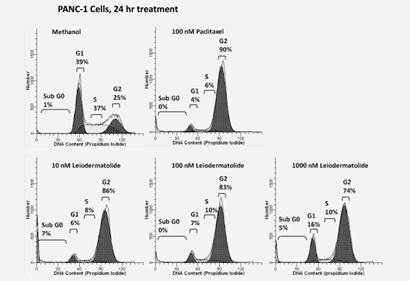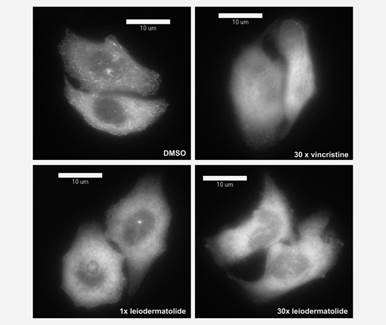


最近,佛罗里达大西洋大学Harbor Branch海洋学研究所的科学家发现,从美国Fort Lauderdale海岸收集的一种深水海绵,含有leiodermatolide——一种天然产物,能够以极低的化合物浓度抑制癌细胞的生长和分裂。这项工作获得了美国专利和商标局的专利奖,支持使用化合物对抗各种形式的癌症。海绵是一个古老的动物群,出现在6亿多年前,与人类有着许多相同的基因。这些科学家正在利用人类和海绵基因组的相似性,从这些生物中分离海洋天然化合物,来开发用于治疗人类疾病(如癌症)的药物。研究人员正在扩大他们的最初发现,最近他们表明,leiodermatolide能降低体内胰腺肿瘤的大小,研究结果刊登在国际著名癌症杂志《International Journal of Cancer》(IJC)。
在美国,胰腺癌是导致癌症死亡的第四大原因。胰腺癌患者在诊断后五年内生存率不超过百分之7,百分之74的患者在诊断的第一年内死亡。近年来,胰腺癌引起了相当的关注,因为许多知名人士死于这种疾病。九月是演员Patrick Swayze去世七周年,十月是苹果公司联合创始人Steve Jobs去世五周年。伟大的男高音歌唱家Luciano Pavarotti在十年前也死于这种疾病。
在这篇题为“Leiodermatolide, a Novel Marine Natural Product, Has Potent Cytotoxic and Antimitotic Activity Against Cancer Cells, Appears to Affect Microtubule Dynamics, and Exhibits Antitumor Activity”的文章中,研究人员更全面地定义了这种海洋化合物如何可以杀死癌细胞,表明其作用不仅对细胞有效,而且它还能够降低胰腺癌的肿瘤重量。
这项研究表明,leiodermatolide可诱导胰腺癌细胞的程序性细胞死亡,并抑制其他癌细胞(如转移性黑色素瘤、结肠癌、淋巴瘤、恶性胶质细胞瘤)的生长。
紫杉醇是一种常用的抗癌药物,通过与微管蛋白相互作用并导致其聚合,而发挥功能。leiodermatolide也与微管蛋白相互作用,但是与其他跟微管相互作用的药物相比,它似乎通过的一种独特的作用机制影响微管动力学。在一种转移性胰腺癌小鼠模型中,当与吉西他滨——胰腺癌的标准护理药物相比较时,leiodermatolide表现出显著的肿瘤减少和控制作用。
Guzmán说:“鉴于其作用机制的独特性、其对癌细胞的效力和选择性、其在体内的疗效,leiodermatolide是一种非常有趣的化合物,还需要进一步的研究来确定它的治疗潜力,以解决一些最具破坏性的癌症形式。”
天然产物,或次生代谢产物,是由生物体产生的小的有机分子。不同于初级代谢产物——如糖、脂肪或蛋白质,这些分子对于维持生命并不是必要的;但是,有研究认为,这些化合物赋予了生产生物一个进化上的优势。例如,如果海绵产生的一种化合物,对食肉动物来说是有毒的或味道不好,海绵可能会保护自己不被吃掉,因此,与不产生这种化合物的海绵相比,它就具备一个优势。除了阻断捕食以外,天然产物在生产生物中可能有许多不同的功能。
FAU Harbor Branch的药物发现计划,打头阵的是Wright,寻找胰腺癌症和传染病的治疗策略,他们也与致力于其他形式的癌症、疟疾、肺结核、神经退行性疾病和炎症等研究的科学家合作。
Wright说:“我们的海洋生物医学和生物技术计划的主要目标是,发现海洋天然产品,作为药物或工具,以让我们更好地了解疾病的过程。”
在去年9月份,来自哈佛大学和其他研究机构的一组研究人员发现,从海绵(sea sponges)中分离、随后在Shair实验室合成的一种分子,可遏止癌细胞的生长,从而为白血病的治疗开辟了新的途径。这项研究发表在国际顶级学术刊物《Nature》。相关阅读:Nature:海绵提取物攻克白血病。
另外,来自美国埃默里大学Winship癌症研究所、芝加哥大学、UT西南医学中心、北京大学和复旦大学等处的科学家发现,在地衣和大黄中提取的一种橙色色素——称为蜈蚣苔素(parietin),可能有潜力作为一种抗癌药。相关研究结果发表在2015年十月十九日的《Nature Cell Biology》。相关阅读:中美学者:一种天然提取物可抗癌。
今年1月份,在《Molecular Oncology》发表的一篇文章中,美国勘萨斯大学癌症中心的徐博士和Neufeld似乎已经发现了一种潜在的药物,是一种棉籽提取物——棉酚,棉花植物中的一种天然成分,目前正处于前列腺癌临床试验的早期阶段。相关阅读:华人学者用棉籽提取物制备抗癌药。(来源:生物通 王英)
Leiodermatolide, a novel marine natural product, has potent cytotoxic and antimitotic activity against cancer cells, appears to affect microtubule dynamics, and exhibits antitumor activity
Abstract Pancreatic cancer, the fourth leading cause of cancer death in the United States, has a negative prognosis because metastasis occurs before symptoms manifest. Leiodermatolide, a polyketide macrolide with antimitotic activity isolated from a deep water sponge of the genus Leiodermatium, exhibits potent and selective cytotoxicity toward the pancreatic cancer cell lines AsPC-1, PANC-1, BxPC-3, and MIA PaCa-2, and potent cytotoxicity against skin, breast and colon cancer cell lines. Induction of apoptosis by leiodermatolide was confirmed in the AsPC-1, BxPC-3 and MIA PaCa-2 cells. Leiodermatolide induces cell cycle arrest but has no effects on in vitro polymerization or depolymerization of tubulin alone, while it enhances polymerization of tubulin containing microtubule associated proteins (MAPs). Observations through confocal microscopy show that leiodermatolide, at low concentrations, causes minimal effects on polymerization or depolymerization of the microtubule network in interphase cells, but disruption of spindle formation in mitotic cells. At higher concentrations, depolymerization of the microtubule network is observed. Visualization of the growing microtubule in HeLa cells expressing GFP-tagged plus end binding protein EB-1 showed that leiodermatolide stopped the polymerization of tubulin. These results suggest that leiodermatolide may affect tubulin dynamics without directly interacting with tubulin and hint at a unique mechanism of action. In a mouse model of metastatic pancreatic cancer, leiodermatolide exhibited significant tumor reduction when compared to gemcitabine and controls. The antitumor activities of leiodermatolide, as well as the proven utility of antimitotic compounds against cancer, make leiodermatolide an interesting compound with potential chemotherapeutic effects that may merit further research.
原文链接:http://onlinelibrary.wiley.com/doi/10.1002/ijc.30253/epdf



